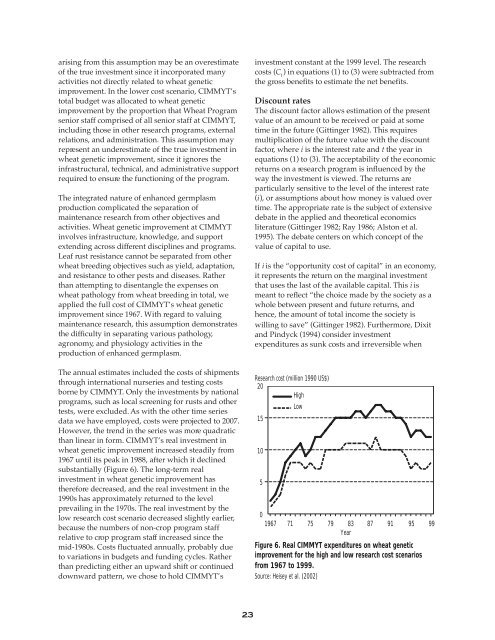The Economic Impact in Developing Countries of ... - AgEcon Search
The Economic Impact in Developing Countries of ... - AgEcon Search
The Economic Impact in Developing Countries of ... - AgEcon Search
- No tags were found...
You also want an ePaper? Increase the reach of your titles
YUMPU automatically turns print PDFs into web optimized ePapers that Google loves.
aris<strong>in</strong>g from this assumption may be an overestimate<strong>of</strong> the true <strong>in</strong>vestment s<strong>in</strong>ce it <strong>in</strong>corporated manyactivities not directly related to wheat geneticimprovement. In the lower cost scenario, CIMMYT’stotal budget was allocated to wheat geneticimprovement by the proportion that Wheat Programsenior staff comprised <strong>of</strong> all senior staff at CIMMYT,<strong>in</strong>clud<strong>in</strong>g those <strong>in</strong> other research programs, externalrelations, and adm<strong>in</strong>istration. This assumption mayrepresent an underestimate <strong>of</strong> the true <strong>in</strong>vestment <strong>in</strong>wheat genetic improvement, s<strong>in</strong>ce it ignores the<strong>in</strong>frastructural, technical, and adm<strong>in</strong>istrative supportrequired to ensure the function<strong>in</strong>g <strong>of</strong> the program.<strong>The</strong> <strong>in</strong>tegrated nature <strong>of</strong> enhanced germplasmproduction complicated the separation <strong>of</strong>ma<strong>in</strong>tenance research from other objectives andactivities. Wheat genetic improvement at CIMMYT<strong>in</strong>volves <strong>in</strong>frastructure, knowledge, and supportextend<strong>in</strong>g across different discipl<strong>in</strong>es and programs.Leaf rust resistance cannot be separated from otherwheat breed<strong>in</strong>g objectives such as yield, adaptation,and resistance to other pests and diseases. Ratherthan attempt<strong>in</strong>g to disentangle the expenses onwheat pathology from wheat breed<strong>in</strong>g <strong>in</strong> total, weapplied the full cost <strong>of</strong> CIMMYT’s wheat geneticimprovement s<strong>in</strong>ce 1967. With regard to valu<strong>in</strong>gma<strong>in</strong>tenance research, this assumption demonstratesthe difficulty <strong>in</strong> separat<strong>in</strong>g various pathology,agronomy, and physiology activities <strong>in</strong> theproduction <strong>of</strong> enhanced germplasm.<strong>The</strong> annual estimates <strong>in</strong>cluded the costs <strong>of</strong> shipmentsthrough <strong>in</strong>ternational nurseries and test<strong>in</strong>g costsborne by CIMMYT. Only the <strong>in</strong>vestments by nationalprograms, such as local screen<strong>in</strong>g for rusts and othertests, were excluded. As with the other time seriesdata we have employed, costs were projected to 2007.However, the trend <strong>in</strong> the series was more quadraticthan l<strong>in</strong>ear <strong>in</strong> form. CIMMYT’s real <strong>in</strong>vestment <strong>in</strong>wheat genetic improvement <strong>in</strong>creased steadily from1967 until its peak <strong>in</strong> 1988, after which it decl<strong>in</strong>edsubstantially (Figure 6). <strong>The</strong> long-term real<strong>in</strong>vestment <strong>in</strong> wheat genetic improvement hastherefore decreased, and the real <strong>in</strong>vestment <strong>in</strong> the1990s has approximately returned to the levelprevail<strong>in</strong>g <strong>in</strong> the 1970s. <strong>The</strong> real <strong>in</strong>vestment by thelow research cost scenario decreased slightly earlier,because the numbers <strong>of</strong> non-crop program staffrelative to crop program staff <strong>in</strong>creased s<strong>in</strong>ce themid-1980s. Costs fluctuated annually, probably dueto variations <strong>in</strong> budgets and fund<strong>in</strong>g cycles. Ratherthan predict<strong>in</strong>g either an upward shift or cont<strong>in</strong>ueddownward pattern, we chose to hold CIMMYT’s<strong>in</strong>vestment constant at the 1999 level. <strong>The</strong> researchcosts (C t) <strong>in</strong> equations (1) to (3) were subtracted fromthe gross benefits to estimate the net benefits.Discount rates<strong>The</strong> discount factor allows estimation <strong>of</strong> the presentvalue <strong>of</strong> an amount to be received or paid at sometime <strong>in</strong> the future (Gitt<strong>in</strong>ger 1982). This requiresmultiplication <strong>of</strong> the future value with the discountfactor, where i is the <strong>in</strong>terest rate and t the year <strong>in</strong>equations (1) to (3). <strong>The</strong> acceptability <strong>of</strong> the economicreturns on a research program is <strong>in</strong>fluenced by theway the <strong>in</strong>vestment is viewed. <strong>The</strong> returns areparticularly sensitive to the level <strong>of</strong> the <strong>in</strong>terest rate(i), or assumptions about how money is valued overtime. <strong>The</strong> appropriate rate is the subject <strong>of</strong> extensivedebate <strong>in</strong> the applied and theoretical economicsliterature (Gitt<strong>in</strong>ger 1982; Ray 1986; Alston et al.1995). <strong>The</strong> debate centers on which concept <strong>of</strong> thevalue <strong>of</strong> capital to use.If i is the “opportunity cost <strong>of</strong> capital” <strong>in</strong> an economy,it represents the return on the marg<strong>in</strong>al <strong>in</strong>vestmentthat uses the last <strong>of</strong> the available capital. This i ismeant to reflect “the choice made by the society as awhole between present and future returns, andhence, the amount <strong>of</strong> total <strong>in</strong>come the society iswill<strong>in</strong>g to save” (Gitt<strong>in</strong>ger 1982). Furthermore, Dixitand P<strong>in</strong>dyck (1994) consider <strong>in</strong>vestmentexpenditures as sunk costs and irreversible whenResearch cost (million 1990 US$)20HighLow1510501967 71 75 79 83 87 91 95 99YearFigure 6. Real CIMMYT expenditures on wheat geneticimprovement for the high and low research cost scenariosfrom 1967 to 1999.Source: Heisey et al. (2002)23
















